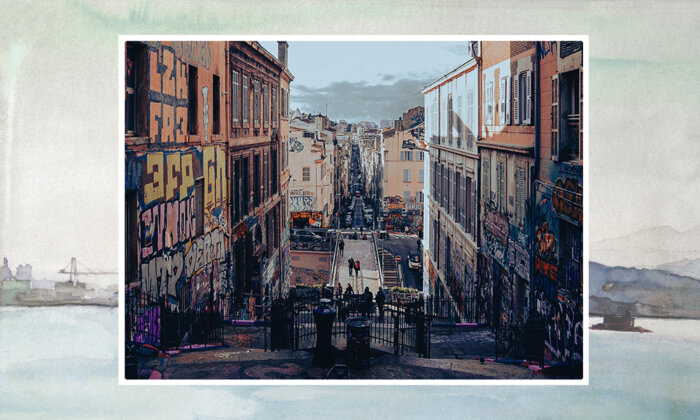Elsewhere: On Marseille and Its Myths

Marseille is a series of invented cities, living as stories and images, sometimes original, sometimes borrowed, strung together without too much concern for the joints and overlaps. There are any number of semi-fictional versions of Marseille, competing with one another and often contradictory — the comic seaside village whose inhabitants doze out in the sun; the haven of gangsters and whores with its carefully staged shoot-outs; the magnificent port, former gateway to the east, now mostly derelict; the multicultural city of immigrants and outcasts, colorful or threatening or both together; the new city of leisure, capital of the would-be land of Provence-California; the city of grainy music videos, with youths shooting up outside mournful housing blocks; the dull bourgeois provincial town where nothing ever happens; the mysterious unknowable city of the Mediterranean coast, with its hills and limestone coves.
All these cities are found in the many books and films about Marseille, each one based on some actual aspect of the city, but also a projection, an overstatement or deliberate distortion, for somehow Marseille more than most cities lends itself to myths and exaggerations. With every characterization the feel of Marseille turns and shifts, the city moves from dangerous to harmless, from healthy to sick, from light to dark. Each of these images creates a different city, a city that is never precisely sited, a city that is always elsewhere.
Galéjade (Provençal: galéja), gallantry, a joke, a fantastic invented story
Blaguer (Provençal: blaga), chatter, talk abundantly
Even an invented story, however, has a basis in some kind of actual place. Somewhere in amongst these images is the actual city, beside the sea, of bricks, stone and concrete, of wharves, ships, cranes and warehouses, of houses and housing blocks. The construction of this city is surprisingly solid, direct and immediate, almost brutally real. The two, the invented and the actual, interact and influence one another — the actual forming the basis for the invented, but the invented also changing the way the actual is seen and sees itself. It is difficult to know which is the original and which is the double, a common theme in the city.
With both eyes closed you can see images from the various narratives all mixed up together, overlaid on top of one another, an impossible city.
With both eyes closed you can see images from the various narratives all mixed up together, overlaid on top of one another, an impossible city, an ever-extending urban galéjade. You can imagine yourself back once more in the actual city, in that curious, very particular light, along the long narrow streets which run straight across the hills, the mixture of people pushing by, the strong and defiant, compelling feeling of being in another place.

The only real way to arrive at Marseille is by boat, approaching gently from across the sea, but except for the ferries from Africa and Corsica few boats arrive in Marseille today. A less diverting but easier method is to arrive from inland, by train. As it moves south, the train speeds for what seems like hours across a landscape of parched hills and plains. Inside, the railway carriage is cool, quiet and comfortable. The seats, the tables, the light, the harmonious colors are all elegantly designed. The passengers mostly ignore one another, absorbed in their individual journeys. The train passes through a long tunnel. There seems to be a moment of pause, nothing happening, just waiting. The train emerges from the tunnel. Sudden light. Tower blocks, low buildings, sheds, factories, roads. Another European city. Yellow-grey color. Nowhere in particular. Except that not far away there appears the grey-blue background of the sea.
There are several exits from Marseille railway station. Perhaps the image a visitor has of the city is determined by the exit they take, as though the very first experience remains the strongest, burnt onto the mind like light onto a slow photographic film. Later experiences may modify this first moment, but can never erase it. Or perhaps the image of the city is already decided before the visitor even arrives, through the rumors and stray information which tumble carelessly through the world, through the pictures and films they have seen. And perhaps these vague impressions subconsciously determine which exit the visitor will take, suggesting one route rather than another, gently steering them to the left of the newsstand rather than the right, pressing them to follow without much thought this group of people rather than others, so that without knowing it the visitor arrives at one version of the city rather than another, and the rest is already decided.
The usual exit to the left of the newsstand in the city’s main Saint-Charles station takes the traveler out onto the grand theatrical steps leading down towards the center of Marseille. Standing at the top of the steps, surprised to be out of the dim light of the station, most visitors pause for a moment to take in a view of the city. The view stretches down the steps, across the statues of women representing the former colonies of Asia and Africa, then along the boulevard d’Athènes, with its dilapidated 19th-century houses, across la Canebière, across the bourgeois houses of the 6th district to the hills and to the sky beyond. Up to the right, on the hill, is the church of Notre-Dame de la Garde, also known as la Bonne Mère. Women all: Asian, African, the good French mother. There are usually some people standing here, at the top of the steps, waiting for a moment, a little hesitant, about to step down into the city, or perhaps about to turn away and leave.
In the confusion of people within the station it is easy to miss the main exit and pass by the newsstand to the right rather than the left, and go down an escalator into a dark corridor, through building works and street reconstructions, barriers and stationary traffic, out to boulevard Charles-Nédélec. Here there is a patch of open land, with ditches and mounds of earth, marked by white labels on sticks. Various men and women sift the earth, apparently looking for archaeological remains. All around there is the heat of the afternoon sun, the rush of traffic. The open land adjoins some undistinguished office buildings and a few tatty structures of uncertain age. A little further on is a great stone arch, once perhaps a grand entry into the city, now marooned in a busy roundabout. Some people push supermarket trolleys laden with boxes. A small copse of trees shelters a group of people with sleeping bags and placards. The visitor seems not to have arrived in a city at all, but in some kind of half-inhabited landscape.
Beside the arch there is a zone of narrow streets, cluttered with merchandise, plastic objects, clothes, jewelry, long-distance call shops, small restaurants selling snacks and tea, the pavements lined by sellers with a few shoes, some electronics, some broken toys. Groups of men sit around doing nothing in particular, as though waiting for something to occur. Without warning, the city seems to have moved into a non-European world, or into a zone which shows that the European world is not always what it is assumed to be. The familiar seems not to be so familiar any more. People push past, but pay no attention.
Never look at the map. To look at the map would certainly be a mistake.
Never look at the map. To look at the map would certainly be a mistake. It would show that the visitor is already lost, and to be visibly lost when everybody else seems to know their way would be too distinctive, too much a sign of not belonging. It is only possible to keep on moving.
By the side of the road there is a small café. All the customers are men, talking amongst themselves or playing cards. Most wear slightly old-fashioned clothes, grey trousers, plastic jackets, unironed shirts. Some wear sports clothing. Just where these men are from is uncertain — North Africa, the Middle East, Eastern Europe or elsewhere.
There’s no need to go any further, it is all already moving too fast. Already there are foreigners and strangeness and a certain romance of the other. Already the old prejudice of Marseille as the city of foreigners is taking over, an ancient myth, a familiar tale, partly true, partly invented. If, however, the point of view becomes a little more objective, removed from the ignorant traveler and his fear of maps and taken into the realm of the geographical, then just where does Marseille belong? The city lies at a point where several different geographies intersect. It is located on various boundaries: land and water, mountain and plain, marshland and limestone, rural and industrial, north and south.
To the northwest are the flat marshy lands of the Camargue and the wild barren zone of the Crau, where the land drops gently into the sea. To the east a ring of high mountains, the last traces of the Alps, forms a great semicircle, cutting the city off from the land beyond and plunging steeply down into the sea to form underwater valleys and ravines. To the southeast are the limestone coves of the Calanques, and then the gentle beaches and ports of the Côte d’Azur. To the west and the south is the sea itself, the only element to which the city naturally connects.
Everything in Marseille follows from the nature of its site and the four elements of sea, mountains, plain and harbor. Each of these four elements complements and interacts with the other three. The sequence of relationships they set up defines the form of the city as well as the contradictions which make it so individual. Like most sequences, this one also has a time limit. At a certain point other elements come into play, and one sequence ushers in the next. The ring of mountains encloses the plain, sheltering it and isolating it. The plain encloses the harbor, allowing it to swell out across the land, but then squeezing it so that it meets the sea through a narrow channel. On either side of the harbor are hills, the northern bank being the original site of the old city.
Seen from out at sea, the city is a mass of buildings dwarfed by the mountains behind. The harbor is invisible, secret, obscured by the narrow entry channel. Seen from up on the mountains — the viewpoint of travelers from the north — the city sprawls formlessly over the plain, with the sea beyond reaching out as an extension to the city. From within the city these mountains have a mysterious and changing quality, at times seeming like a distant backdrop, alien to the city, at other moments very near and clear. As the sun sets, the peaks of the mountains light up, often with unexpected violets and purples as if some mineral were shining from within their mass, while the plain and the harbor are already in shadow. The city is in large part constructed from the limestone quarried from the sides of these mountains. The city and the mountains often appear as one mass, with one color — a pale yellowish grey — also always changing in tone.
Inland, on the plain, there are zones with enough soil for trees and some crops to grow, for grazing and small farms, and for the diminutive châteaux known as bastides or bastidons which the Marseille rich constructed for pleasure and for hunting. Once there were also farms and vineyards on the plain, nourished by three rivers: the Huveaune, Aygalades and Jarret. The Marseille urban zone is large and irregularly populated, twice the area of Paris but with a ninth of the population. It contains stretches of countryside, beaches, woods, hills, the limestone Calanques, some islands. There is still a rural feel to parts of the city, which now stretches out over the plain, as though the blocks and towers were out in the countryside rather than in an urban zone. This landscape hints at other places. It seems Italian with its dry vegetation and sudden moments of fertility, Greek with its limestone islands and coves, Levantine with its hills bare but for a few scraggy trees, north African with its mountains and its barrenness. It is occasionally also curiously northern, with its rows of docks and refining industries, a kind of Liverpool.
Marseille-Africa has a long tradition. The last scenes of Julien Duvivier’s 1937 film “Pépé le moko” are set in Algiers but are actually filmed in Marseille, the city effortlessly standing in for its southern sister (Le moko is 1930s slang for a “man from Marseille”). Longing to return with his lover to France, Jean Gabin plays an elegant and tragic crook, ultimately dying by his own hand at the gates of Marseille’s la Joliette port rather than the actual harbor of Algiers. Pépé dies failing to return to a country he is already in. In the wonderful slow pan across the city’s sea front which begins Robert Guédiguian’s “La ville est tranquille” (partly across the same docks shown in “Pépé le moko”), the landscape of the city appears parched, un-European, as though the city had remained somehow African.
And in J. M. G. Le Clézio’s 1980 novel “Desert,” a story of a young woman from the Sahara who flees to Marseille, the city is described as a kind of Sahara: up in the hills above the city “something turns within her, like a vertigo or a wind. It is perhaps the chergui, the desert wind, which arrives here having crossed seas, mountains, roads and cities.” Throughout the book the city is seen as a kind of reflection on the Sahara, a northern wasteland, both hot and cold, occupied by the North Africans who have arrived here but whose affinities are still with the desert. These fictive relocations are paralleled by actual life, for part of the attraction for those fleeing the collapse of French colonial rule in Algeria in the 1960s was that Marseille appeared already familiar, since with its barren hills it seemed like another North African city.
In summer the heat builds up, trapped in the bowl created by the ring of mountains. In winter Marseille seems like another place: often cold, wet, melancholic, with weather from the Atlantic. The Mistral scours the land intermittently in spring and winter, bringing dry air from the Alps. The people who originally settled in this area protected themselves from the climate. They built pragmatic, small-windowed houses of stone or brick, and laid out narrow winding streets to avoid the blasts of wind and create shade, in well-protected places, looking away from the sea. The classical, tall three-windowed houses and the straight streets, narrow and shady, were suited to the climate — only those who came much later found nature charming and built for the sun and the sea.
The visitor seems not to have arrived in a city at all, but in some kind of half-inhabited landscape.
The city has been a meeting point for the land and the sea, economically dependent on the junction of the two, its trade based on moving goods from the Mediterranean and beyond northwards into the industrial zones of Western Europe, through the Rhône valley and the Alpine passes. These trade routes, indispensable to the city’s survival, connect it to the land and to the cities of the north. But the mountains have always defined the limits of the city: it has spread over the plain to the edge of the slopes, but never really controlled any outlying area, never really been part of Provence, never developed into a city-state. Nearby Provençal cities like Aix and Avignon, which have been more involved in governing and administering the surrounding areas, already seem to be in another country. The citizens of Marseille have often considered France and Europe as part of the outside, and northerners have responded in kind, seeing Marseille as an alien world beyond their own. The city is not really inside Europe at all. Perched uneasily on the hills beside the coast, the whole site orientates itself naturally away from the land and towards the sea. Marseille is an enclave looking out across the sea, to the mountains along the African coast, and to the vast desert of the Sahara beyond. It calls out to the south, even if it is located in the north.
“Whoever is born and has grown up in Marseille has no need to depart, he has already departed,” wrote André Suarès in his book on the city, “Marsiho.” “Where? Elsewhere. To what aim? Why? Elsewhere is the name of an unknown land, the most beautiful of countries. Elsewhere is the country where one is not, and where one could be; where no one has been, until he is there.” Marseille, implied Suarès, doesn’t just lead to elsewhere, it is already elsewhere.
William Firebrace is an architect and writer in London. He is the author of a trilogy of books: “Marseille Mix,” “Memo for Nemo,” and “Zickzack.” This article is excerpted from “Marseille Mix.”
